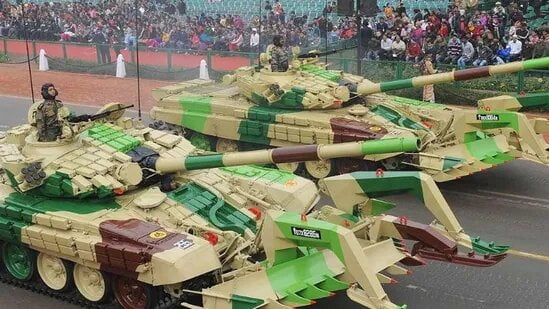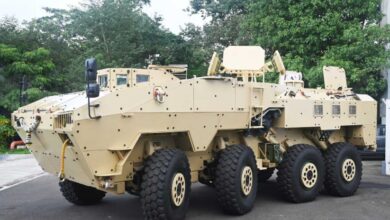MoD Bans Import Of 18 Significant Defence Platforms

- The innovations for defence excellence (iDEX) approach is being used to construct a single weapon system called a "low orbit pseudo-satellite."
- The development of a "anti-jamming system for numerous platforms" under the Make-II technique is the last single weapon system that is proposed.
The identities of eighteen significant defence platforms that can no longer be imported were made public by the Ministry of Defence (MoD) on Friday in Parliament. In its place, domestic industry will now design and develop (D&D) them locally.
In a written response to a parliamentary question, the MoD stated: “In continuous pursuit of achieving self-reliance in defence manufacturing under ‘Aatmanirbhar Bharat Abhiyan’ and in sync with the announcement made in the Union Budget 2022-23 that allocated 25% of the defence R&D budget for industry-led R&D, 18 major platforms have been identified and announced by the MoD for industry led D&D.”
Army platforms like a light-weight tank, self-healing minefields, and “plug-and-play housing” for soldiers stationed at extremely high altitudes are a few examples of these. The 127 millimetre naval gun for capital warships is among the platforms for the navy, while the stand-off airborne jammer and the eagerly anticipated Indian Multi-Role Helicopter (IMRH) are among those for the air force.
18 Items that will be made in India
| Make-1 | Make-2 | Special Purpose Vehicle | iDEX |
| Hypersonic glide vehicles | Anti-jamming systems for varied platforms | Long-range unmanned aerial vehicles (UAVs) | Low-orbit pseudo-satellites |
| Directed Energy Weapons (>300 KW) | Indian multi-role helicopter (IMRH) | ||
| Light-weight tank | |||
| Self-healing minefields | |||
| Unmanned autonomous AI-based land robot | |||
| 127 mm naval gun | |||
| 127 mm guided projectile | |||
| Autonomous AI-based land robot | |||
| Standoff air-borne jammer | |||
| Lithium-ion/ Lithium-sulphur cells [replacing conventional hydrocarbons] | |||
| Communication systems: AFNET switches, routers, encryptors & VOIP phones | |||
| Electro-optical pod (to be subsequently upgraded to EO/IR) with high-res sensing | |||
| ‘Plug and Play’ housing/ infrastructure for soldiers posted at extreme altitudes | |||
Defence sector observers note out that the MoD has published three lists of defence equipment whose import is prohibited, commencing in August 2020. The import of 101 products is progressively prohibited by the August 2020 list, and the embargo is getting greater every year.
The MoD released a second list of 108 defence products in June 2021, gradually outlawing their import. The second list, known as the “Positive Indigenization List,” which often invoked “Atmanirbhar Bharat,” included 209 defence products that must be required to be purchased from Indian businesses, with the number increasing yearly until 2025.
69 goods from the first list had their import embargo lifted on January 1st, 2021. The ban was extended to 60 additional goods on January 1, 2022. The import of 25 more items will be prohibited at the end of 2022, 25 more at the end of 2023, 21 more at the end of 2024, and nine at the start of 2026.
The relationship between the most recent import embargo list and the two earlier ones is unclear.
The defence sector is dubious about whether or not these lists put any pressure on indigenous development. It is unnecessary to prohibit the import of tracked guns because the army already purchases the K9 Vajra system that Larsen & Toubro (L&T) manufactures outside of Pune under a South Korean licence.
Towed artillery and Pinaka multi-barrelled rocket launchers are currently being developed by the DRDO, Kalyani Group, and Tata Aerospace and Defence. Similar to this, Chennai has long produced all of the army’s tank needs, and Medak has produced all of its infantry combat vehicles. It serves little use to prohibit the import of platforms that are already being created in India.
Similar to this, preventing the import of naval warships serves little benefit given that the majority of them are already being built in Indian shipyards. Only two frigates are being built in Russia, while 46 of the 48 warships now under construction are being built in India, according to official naval statistics.
Similar to this, with the recent exception of the Rafale, Hindustan Aeronautics Ltd (HAL) already manufactures the majority of the air force’s fighter and trainer aircraft in India. Since aircraft like the Tejas Mark 1A and the Light Combat Helicopter are designed and produced domestically, as is the HTT-40 basic training aircraft, banning their import serves little purpose.
The MoD stated that the “18 platforms (announced on Friday) have been distributed among the four indigenous paths specified in the Defense Acquisition Procedure-2020, namely Make-I, Make-II, Special Purpose Vehicle (SPV), and Innovations for Defence Excellence (iDEX).
The services, DRDO, and the defence industry held lengthy deliberations to determine these 18 systems, according to the MoD.
The majority of the platforms, 14 out of the 18 identified, will be developed in accordance with the Make-I procedure of the 2021 Defense Acquisition Procedure, according to the MoD.
Under the “Special Purpose Vehicle” (SPV) architecture, the high altitude, long endurance (HALE) unmanned aerial vehicle (UAV) and, separately, the Indian multi-role helicopter, are two key weapons platforms that will be developed (IMRH).
The innovations for defence excellence (iDEX) approach is being used to construct a single weapon system called a “low orbit pseudo-satellite.”
The development of a “anti-jamming system for numerous platforms” under the Make-II technique is the last single weapon system that is proposed.
These major platforms, according to the Minister of State for Defense, “have been identified taking into consideration multiple factors like the capabilities of Indian industry, being cost effective, faster and scalable; current technological advancements; requirement of future warfare; operational challenges; need for import substitution, etc.”







Facebook Comments